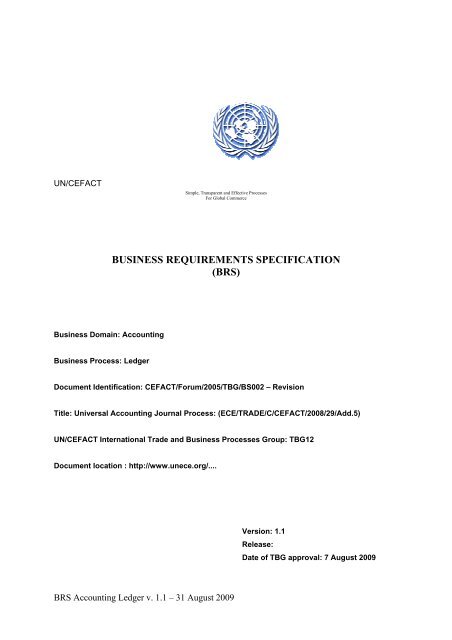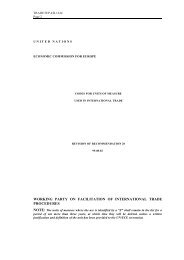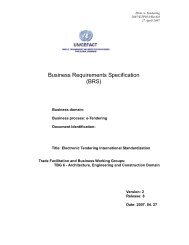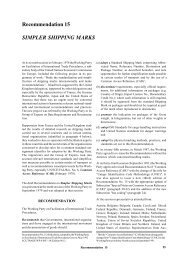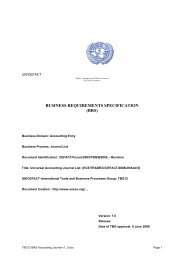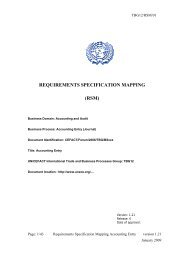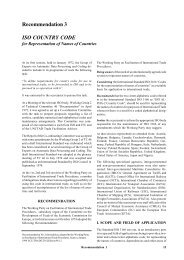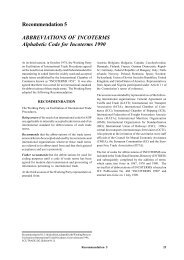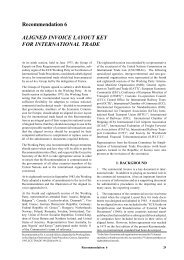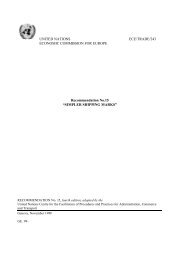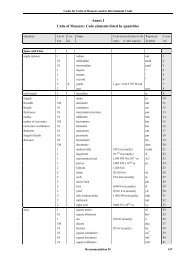Business Requirements Specification (BRS) for Accounting Ledger v
Business Requirements Specification (BRS) for Accounting Ledger v
Business Requirements Specification (BRS) for Accounting Ledger v
Create successful ePaper yourself
Turn your PDF publications into a flip-book with our unique Google optimized e-Paper software.
UN/CEFACT<br />
Simple, Transparent and Effective Processes<br />
For Global Commerce<br />
BUSINESS REQUIREMENTS SPECIFICATION<br />
(<strong>BRS</strong>)<br />
<strong>Business</strong> Domain: <strong>Accounting</strong><br />
<strong>Business</strong> Process: <strong>Ledger</strong><br />
Document Identification: CEFACT/Forum/2005/TBG/BS002 – Revision<br />
Title: Universal <strong>Accounting</strong> Journal Process: (ECE/TRADE/C/CEFACT/2008/29/Add.5)<br />
UN/CEFACT International Trade and <strong>Business</strong> Processes Group: TBG12<br />
Document location : http://www.unece.org/....<br />
Version: 1.1<br />
Release:<br />
Date of TBG approval: 7 August 2009<br />
<strong>BRS</strong> <strong>Accounting</strong> <strong>Ledger</strong> v. 1.1 – 31 August 2009
0. Document Change History Log<br />
Date of change Version Paragraph changed Summary of changes<br />
02.2009 0.1 First draft Submitted to<br />
EEG11 / EDIFICAS<br />
05.2009 1.0 Submission to TBG<br />
Steering<br />
Model<br />
Include ABIEs<br />
07.08.2009 1.01 TBG StC Approval Approval date on<br />
cover page<br />
31.08.2009 1.1 Conceptual model Update with TBG17<br />
harmonization<br />
changes<br />
<strong>BRS</strong> <strong>Accounting</strong> <strong>Ledger</strong> v. 1.1 – 31 August 2009
<strong>Business</strong> <strong>Requirements</strong> <strong>Specification</strong><br />
Table of Contents<br />
0. Document Change History Log................................................................................... 2<br />
1. Preamble ....................................................................................................................... 4<br />
2. References ..................................................................................................................... 6<br />
3. Objective .......................................................................................................................6<br />
4. Scope.............................................................................................................................. 8<br />
5. <strong>Business</strong> <strong>Requirements</strong> ................................................................................................ 9<br />
5.1 <strong>Business</strong> Domain Environment ................................................................................ 9<br />
5.2 <strong>Business</strong> Domain view............................................................................................. 10<br />
5.3 <strong>Business</strong> requirements views................................................................................... 14<br />
5.4 <strong>Business</strong> process elaboration – Audit <strong>Business</strong> Process........................................ 15<br />
5.4.1 Use Case Audit <strong>Business</strong> Process .................................................................15<br />
5.5 In<strong>for</strong>mation flow definition – Audit <strong>Business</strong> Process .......................................... 17<br />
5.5.1 Activity Diagram Audit <strong>Business</strong> Process .......................................................17<br />
5.5.2 <strong>Business</strong> Collaboration Diagram Audit <strong>Business</strong> Process..............................18<br />
5.6 In<strong>for</strong>mation Model Definition – <strong>Ledger</strong> (class diagram) ...................................... 19<br />
5.6.1 <strong>Ledger</strong>.............................................................................................................19<br />
5.6.2 Conceptual <strong>Ledger</strong> Data Model and ABIEs ....................................................20<br />
5.6.2.1 <strong>Accounting</strong>_ <strong>Ledger</strong>. Details ...................................................................... 21<br />
5.6.2.2 Booked_ <strong>Accounting</strong> Account. Details....................................................... 22<br />
5.6.2.3 Posted_ <strong>Accounting</strong> Entry Line. Details..................................................... 24<br />
5.6.2.4 Posted_ <strong>Accounting</strong> Entry. Details ............................................................. 26<br />
5.6.2.5 Evidence_ Document. Details..................................................................... 28<br />
5.6.2.6 Originator_ <strong>Accounting</strong> Voucher. Details .................................................. 29<br />
5.6.2.7 Posted_ <strong>Accounting</strong> Line Monetary Value. Details ................................... 30<br />
5.6.2.8 Portioned_ Monetary Allocation. Details ................................................... 32<br />
5.6.2.9 Delimited_ Period. Details.......................................................................... 33<br />
5.6.2.10 Portioned_ Monetary Instalment. Details ................................................... 34<br />
5.6.2.11 Fiscal_ Tax. Details .................................................................................... 35<br />
5.6.2.12 Reference_ <strong>Accounting</strong> Line Index. Details............................................... 37<br />
5.6.2.13 Linked_ Report. Details.............................................................................. 38<br />
<strong>BRS</strong> <strong>Accounting</strong> <strong>Ledger</strong> v. 1.1 – 31 August 2009
1. Preamble<br />
<strong>Accounting</strong> technique accompanies the business background <strong>for</strong> more than five centuries<br />
when Luca Pacioli, a Venetian monk, first published in 1494 the guidance of double entry<br />
bookeeping in his Summa (Summa de arithmetica, geometria, proportioni et proportionalita ),<br />
in which he gives credit to Benedetto Contrugli (Benedikt "Beno" Kotruljević , who actually<br />
wrote the materials in his "LIBRO DE L'ARTE DE LA MERCATURA".<br />
The genuine fundamentals of the accounting business were then postulated. They still are<br />
presently entries journalizing and registration into accounts defined be<strong>for</strong>ehand in the list of<br />
accounts (also called “chart”) used in the enterprise. Different charts of accounts possibly<br />
provide accounts identifiers <strong>for</strong> different accounting sub domains such as budget, financial,<br />
cost accounting, etc.<br />
From then onward, a few changes occurred in the very basic practice of debit-credit entries.<br />
On the contrary, many happened in the environment of bookkeeping and audit trail in<br />
particular from the voucher toward accounts and back from accounts to the document that<br />
makes evidence of the entry.<br />
Much more than ever be<strong>for</strong>e, the last ten years (the Internet Years) did hit the businesses of<br />
both accountant and auditor. EDI first, internet and ebXML now nurture a drastic shift still to<br />
achieve in e-business documents efficient liaison with accounting entries collection,<br />
accounting books assembly, audit drill down and around and financial reporting.<br />
The deep changes still to achieve with electronic business evolving maturity opens<br />
speculations on the revisited relationship of the enterprise’s operational activities with<br />
accounting process. In particular, standardized content of accounting books offer potentially<br />
unexpected software developments <strong>for</strong> computer assisted audit tools including <strong>for</strong> medium<br />
sized and smaller businesses.<br />
In many respects it is obvious that in the course of its daily duty accounting will have to<br />
“deliver more <strong>for</strong> less ef<strong>for</strong>t” as well as other enterprise’s departments. Standardized input –<br />
output interface of accounting data elements, entries and books will improve productivity of<br />
the accounting function, be it either internally incorporated or externalised far away of the<br />
business.<br />
Connecting [e-]documents to accounts, both ways.<br />
ENTERPRISE<br />
EVENT<br />
AGENT<br />
RESOURCE<br />
SUPPLIERS<br />
BUY<br />
PAYROLL<br />
INVENTORY<br />
DEPRECIATION<br />
SELL<br />
CUSTOMERS<br />
<strong>Accounting</strong> Backbone<br />
LEDGER, AP, AR, Cost, Budget, …<br />
From point to point toward end-to-end<br />
<strong>BRS</strong> <strong>Accounting</strong> <strong>Ledger</strong> v. 1.1 – 31 August 2009
The current practice of exchange of business documents by means of telecommunications –<br />
usually defined as e-<strong>Business</strong> presents a major opportunity to improve the competitiveness of<br />
companies, especially <strong>for</strong> Small and Medium Enterprise (SME) whatever its size can be.<br />
About all the functions within any entity provide input to accounting entries and accounting<br />
entries in turn will provide output towards aggregated figures from accounts.<br />
Each individual accounting entry, with standardized tagged elements is the basis <strong>for</strong> a very<br />
powerful tool and from this point on, the [no longer missing] link between e-<strong>Business</strong> and e-<br />
<strong>Accounting</strong> / Web<strong>Ledger</strong>.<br />
Carrying on an initiative of EDIFICAS Europe, the European Expert Group 11 (EEG11) –<br />
<strong>Accounting</strong> and auditing – started the discovery of elements <strong>for</strong> accounting entries in 2004.<br />
This task was inter alia based upon the ENTREC, CHACCO, INFENT and LEDGER Edifact<br />
messages.<br />
The “<strong>Accounting</strong> Entry” message is a recognized UN-Cefact standard included in CLL08B.<br />
LEDGER is based upon the complete set of ABIEs of the “<strong>Accounting</strong> Entry”.<br />
This first version of the <strong>Business</strong> <strong>Requirements</strong> <strong>Specification</strong> (<strong>BRS</strong>) is presented <strong>for</strong><br />
comments from the other regions.<br />
After a period of public exposure TBG12 will draft the final version of the <strong>BRS</strong> addressing<br />
comments received and <strong>for</strong>ward <strong>for</strong> further processing through the UN/CEFACT Forum<br />
process with the goal of developing a UN/CEFACT standard LEDGER document.<br />
The purpose of this document is to define globally consistent LEDGER processes <strong>for</strong> the<br />
worldwide accounting and auditing domains, using the UN/CEFACT Modelling Methodology<br />
(UMM) approach and Unified Modelling Language to describe and detail the business<br />
processes and transactions involved.<br />
The structure of this document is based on the structure of the UN/CEFACT <strong>Business</strong><br />
<strong>Requirements</strong> <strong>Specification</strong> (<strong>BRS</strong>) document reference CEFACT/ICG/005.<br />
<strong>BRS</strong> <strong>Accounting</strong> <strong>Ledger</strong> v. 1.1 – 31 August 2009
2. References<br />
• United Nations Trade Data Elements Dictionary (UNTDED) – ISO 7372<br />
http://www.unece.org/cefact/standar/docs/tded.htm<br />
• UN/CEFACT TBG12 <strong>Accounting</strong> Entry <strong>BRS</strong>:<br />
http://www.uncefact<strong>for</strong>um.org/TBG/TBG12/TBG12%20Documents/<strong>BRS</strong>%20accounting<br />
%20Entry%20v1_2_final.zip<br />
• UN/CEFACT TBG12 <strong>Accounting</strong> Entry RSM:<br />
http://www.uncefact<strong>for</strong>um.org/TBG/TBG12/TBG12%20Documents/RSM%20accounting<br />
%20entry%201.0_final.zip<br />
• UN/CEFACT Core Components Library CCL09A<br />
http://www.unece.org/cefact/codes<strong>for</strong>trade/unccl/CCL09A.xls<br />
• UN/CEFACT <strong>Accounting</strong> Entry Standard (CCL08B Standards)<br />
• UN/CEFACT Modelling Methodology (CEFACT/TMG/N090R10, November 2001<br />
• UN/CEFACT –ebXML Core Components Technical <strong>Specification</strong>s version 2.01 – ISO<br />
15000-5<br />
• UN/CEFACT <strong>Business</strong> <strong>Requirements</strong> <strong>Specification</strong> version 1.5 (CEFACT/ICG/005)<br />
• TRADE/CEFACT/2008/MISC.1 / Decision 08-09 ECE/TRADE/C/CEFACT/2008/29/Add.5<br />
• UN/CEFACT TBG Library 2005-01-25<br />
• UN/EDIFACT – ENTREC message<br />
• Unified Modelling Language (UML version 1.4.2)<br />
3. Objective<br />
The objective of this document is to standardize the in<strong>for</strong>mation entities and the extraction<br />
business processes, (occasionally snippets only) of the <strong>Ledger</strong> or sub-<strong>Ledger</strong>s used by the<br />
enterprises based on the one hand<br />
- on the Chart of accounts standard data model (to be developed in CCL09B) and on the<br />
<strong>Accounting</strong> Entry standard data model<br />
and on the other hand<br />
- on audit business processes and/or matching entry lines contained into customers /<br />
suppliers opposed accounts of different parties.<br />
A <strong>Ledger</strong> is also likely the preferred source <strong>for</strong> migration of accounting system or <strong>for</strong><br />
archiving accounting in<strong>for</strong>mation.<br />
A <strong>Ledger</strong> is an accounting document that organizes accounts’ sorting of collected accounting<br />
entries with respect to a chart of accounts adopted by the entity, sometimes mandatorily<br />
applicable to the business<br />
Originally captured into journal or sub journals, accounting entries are sequentially rearranged<br />
in chronological order into the allotted accounts in a journal. This re-ordered book is the<br />
<strong>Ledger</strong>.<br />
A <strong>Ledger</strong> is a different view of all accounting entries booked in all journals during a period of<br />
time. It is one among the fundamental instruments <strong>for</strong> an auditor to <strong>for</strong>ge his opinion on the<br />
timeliness, accuracy and completeness of the accounting process applied in an entity.<br />
<strong>BRS</strong> <strong>Accounting</strong> <strong>Ledger</strong> v. 1.1 – 31 August 2009
From a document, it is possible to retrieve in the <strong>Ledger</strong>, all the booking in<strong>for</strong>mation in the<br />
right journal on the right accounting account.<br />
And vice versa, from an account in a <strong>Ledger</strong>, it is possible to retrieve all lines of an<br />
accounting entry up to its supporting document which may be either internal or external, such<br />
as a payroll, a spreadsheet, a provision <strong>for</strong> amortization, a provision <strong>for</strong> revenue, an invoice, a<br />
bank statement, etc.<br />
The <strong>Ledger</strong> standard is applicable <strong>for</strong> financial accounting, cost accounting, provisional or<br />
budgetary accounting, and more generally <strong>for</strong> any kind of various dimensions and numerous<br />
analytical accounting processes.<br />
The business document consists of a set of <strong>Business</strong> In<strong>for</strong>mation Entities (BIE), which are<br />
preferably taken from libraries of reusable business in<strong>for</strong>mation entities, in particular those of<br />
the <strong>Accounting</strong> Entry standard. The contents of the business document and the <strong>Business</strong><br />
In<strong>for</strong>mation Entities are presented using class diagrams.<br />
<strong>BRS</strong> <strong>Accounting</strong> <strong>Ledger</strong> v. 1.1 – 31 August 2009
4. Scope<br />
This section describes the extent and limits of the <strong>Ledger</strong> business process within the chain<br />
being described in this document. The class diagram of the <strong>Ledger</strong> is developed in such a<br />
way that it specifies the cross industry reusable business in<strong>for</strong>mation entities.<br />
The business process may concern either data migration from a <strong>for</strong>mer accounting system or<br />
take over data from different accounting systems to integrate accounting books of merging<br />
entities or to extract any kind of abstract of accounts under scrutiny from the complete <strong>Ledger</strong><br />
book.<br />
It allows the extension of industry specific business in<strong>for</strong>mation entities such as account<br />
specification details to describe main and / or sub accounts <strong>for</strong> specific general account, cost<br />
accounting account, budget account, and as many accounts dimensions - or axes - as needed.<br />
It is up to each industry to specify, based on the <strong>BRS</strong> of the classical double accounting entry,<br />
its industry specific accounting <strong>Ledger</strong> content.<br />
Categories<br />
Description and Values<br />
<strong>Business</strong> process<br />
<strong>Accounting</strong> process, Auditing process<br />
Product Classification All<br />
Industry Classification All<br />
Geopolitical<br />
Global<br />
Official Constraint Generally Admitted <strong>Accounting</strong> Principles ;<br />
Classical Double <strong>Accounting</strong> entry<br />
<strong>Business</strong> Process Role Bookkeeper, Accountant, Auditor<br />
Supporting Role<br />
None<br />
System Capabilities No limitations<br />
<strong>BRS</strong> <strong>Accounting</strong> <strong>Ledger</strong> v. 1.1 – 31 August 2009
5. <strong>Business</strong> <strong>Requirements</strong><br />
5.1 <strong>Business</strong> Domain Environment<br />
<strong>Accounting</strong> Entry Capture, Journals, Chart(s) of Accounts, Supply Chain Management, Sales<br />
Management, Finance and Payroll Management, Cost and Budget accounting are all part of<br />
<strong>Ledger</strong> processing in accounting business environment. It may happen that the <strong>Ledger</strong> is<br />
divided into several specialized sub-ledgers.<br />
Suppliers<br />
Inventory<br />
Customers<br />
Supplies<br />
Managmt<br />
Cost<br />
Forecast<br />
Budget<br />
Orders<br />
Managmt<br />
Invoice<br />
General<br />
<strong>Ledger</strong><br />
Invoice<br />
Payroll<br />
Payables<br />
Finance<br />
Receivables<br />
<strong>BRS</strong> <strong>Accounting</strong> <strong>Ledger</strong> v. 1.1 – 31 August 2009
5.2 <strong>Business</strong> Domain view<br />
Because the <strong>Ledger</strong> is the source <strong>for</strong> many queries, it is the place that recreates the link of an<br />
entry line with the source document and to retrieve all entry lines composing the accounting<br />
entry related to a source document.<br />
Aggregation of in<strong>for</strong>mation at account level each line makes possible to reconcile the entry<br />
line with the source document and the justifying voucher.<br />
On audit business processes, the <strong>Ledger</strong> also enables matching of entry lines contained into<br />
customers / suppliers opposed accounts of different parties.<br />
Agents<br />
Chart of Accounts<br />
Accounts Payable<br />
Accounts Receivable<br />
Order Entries<br />
Purchasing<br />
Assets<br />
Human Resource<br />
Payroll<br />
Resources<br />
Automated Entries<br />
Inventory adjustments<br />
Manual Entries<br />
Events<br />
Invoice<br />
Cash<br />
etc<br />
Aggregation<br />
Trial Balance<br />
Sub-<strong>Ledger</strong>(s)<br />
<strong>Ledger</strong><br />
Journal<br />
Entry<br />
Voucher<br />
Data Mining, Extraction,<br />
Consolidation, Audit, Control<br />
Reporting<br />
Regulatory Reports<br />
Financial Statements<br />
VAT Return<br />
Income Tax Return<br />
Forecast<br />
Statistics<br />
Analysis<br />
etc,<br />
Source<br />
Documents<br />
<strong>Accounting</strong> and Audit Domain<br />
<strong>BRS</strong> <strong>Accounting</strong> <strong>Ledger</strong> v. 1.1 – 31 August 2009
<strong>Business</strong> Domain View<br />
Some application cases:<br />
Selection<br />
Criteria<br />
Query<br />
Audit<br />
Process<br />
What <br />
Document<br />
Entries<br />
Journal,<br />
Amount,<br />
Date, etc<br />
Account<br />
Balance<br />
Amount<br />
Last Change<br />
Responsible<br />
Person Name,<br />
Validation<br />
Date, etc.<br />
One account One – Many Entries Lines Logical sign One<br />
Accounts<br />
series<br />
Many / All Entries Lines<br />
/<br />
Value Many<br />
<strong>Accounting</strong><br />
System<br />
Migration<br />
Archiving<br />
<strong>Accounting</strong><br />
file(s)<br />
Report /<br />
return /<br />
declaration<br />
Others<br />
Entries<br />
all all all all Chart of<br />
Accounts<br />
all all all all Chart of<br />
Accounts<br />
Reporting<br />
nomenclature<br />
In a delimited<br />
period<br />
all all Mapping Chart<br />
of Accounts<br />
<strong>BRS</strong> <strong>Accounting</strong> <strong>Ledger</strong> v. 1.1 – 31 August 2009
<strong>Business</strong> Domain Model<br />
<strong>Business</strong> AUDIT and ACCOUNTING<br />
Domain<br />
Model Name<br />
Description Each entry has been booked with different entry lines on different accounts<br />
from supporting documents.<br />
From a line in an account, audit permits to drill up to the source document<br />
and drill around to retrieve all the lines of a same accounting entry.<br />
Industry<br />
All<br />
<strong>BRS</strong> <strong>Accounting</strong> <strong>Ledger</strong> v. 1.1 – 31 August 2009
<strong>Business</strong> Model Administration In<strong>for</strong>mation<br />
<strong>Business</strong> Audit<br />
process name<br />
Analysts / Bergström Jan<br />
Modelers / Bernard Alain<br />
Reviewers Cohen Eric E. (from <strong>BRS</strong> <strong>Accounting</strong> Entry)<br />
Colo Gérard<br />
de Bonhome Olivier<br />
Faverio Dominique<br />
Gasch Stéphane<br />
Lemense Robert<br />
Lesourd Michel<br />
Marchal Benoît<br />
Pajon Alex<br />
Model Owner EDIFICAS Eu, UN-CEFACT<br />
Identifier In<strong>for</strong>mation<br />
Agency Id http://www.edificas.eu<br />
Agency Edificas<br />
<strong>Business</strong> Area Description<br />
<strong>Business</strong> Area AUDIT<br />
Name<br />
Description <strong>Accounting</strong> <strong>Ledger</strong><br />
Scope Standard <strong>Ledger</strong> model<br />
Process Areas <strong>Accounting</strong>, Audit, Archive<br />
Objective<br />
<strong>Business</strong><br />
Opportunity<br />
Category<br />
<strong>Business</strong><br />
Areas<br />
Extract, Drill up, drill down and around accounting <strong>Ledger</strong> (sub-ledgers) and<br />
accounting books.<br />
Standard accounting ledger interface;<br />
Computer assisted audit software;<br />
Electronic archiving.<br />
Accountant, Bookkeeper, <strong>Accounting</strong> / Audit Firm, Financial analyst<br />
Audit, <strong>Accounting</strong>, Finance<br />
<strong>BRS</strong> <strong>Accounting</strong> <strong>Ledger</strong> v. 1.1 – 31 August 2009
5.3 <strong>Business</strong> requirements views<br />
The main functions of accounting are:<br />
- to record financial flow into classical accounting entries into the Journal or auxiliary<br />
sub-journals in order to populate books in the accounting system;<br />
- to sort these entries into (sub-)<strong>Ledger</strong>(s) book(s);<br />
- to aggregate accounts from (sub-)<strong>Ledger</strong>(s) into Trial Balance book;<br />
- to aggregate Trial Balance book into defined reporting <strong>for</strong>ms;<br />
- to archive accounting books, entries, supporting documents in a reusable <strong>for</strong>mat;<br />
- to select and extract sample set(s) of entries or entry lines in order to get and<br />
deliver truth and fairness assurance;<br />
- to select the whole accounting records <strong>for</strong> accounting system migration or archive<br />
purposes.<br />
The place of <strong>Ledger</strong> in the accounting and audit domains<br />
<strong>BRS</strong> <strong>Accounting</strong> <strong>Ledger</strong> v. 1.1 – 31 August 2009
5.4 <strong>Business</strong> process elaboration – Audit <strong>Business</strong> Process<br />
5.4.1 Use Case Audit <strong>Business</strong> Process<br />
The main goal of the auditor is to get assurance that a “true and fair view” of the business is<br />
perfectly reflected by accounting books.<br />
To get such certainty, he will carry successive investigation using selective extractions from<br />
accounting ledger(s).<br />
Use Case Diagram<br />
<strong>BRS</strong> <strong>Accounting</strong> <strong>Ledger</strong> v. 1.1 – 31 August 2009
Use case description – Audit process<br />
<strong>Business</strong><br />
process name<br />
Identifier<br />
Actors<br />
Description<br />
Pre-condition<br />
Postconditions<br />
Scenario<br />
Remarks<br />
Audit Process<br />
<strong>Accounting</strong> audit<br />
<strong>Accounting</strong> Processing System, Auditor<br />
<strong>Accounting</strong> audit is the way <strong>for</strong> an auditor to per<strong>for</strong>m search and query<br />
processes in order to gain an opinion on the true and fair value expressed by<br />
the accounting system and the internal organization with respect to the<br />
general accounting admitted principles.<br />
Extraction analysis criteria must be defined.<br />
Obtain significant snippets to analyse so that the auditor is able to conclude<br />
audit process and express a reasonable opinion about the value of the<br />
accounting system and procedures.<br />
Per<strong>for</strong>m search and query on <strong>Ledger</strong> according to analysis criteria;<br />
Analyses obtained responses;<br />
Expresses an opinion on the true and fair value depending on obtained<br />
responses.<br />
The process described here can be per<strong>for</strong>med by an external auditor, or an<br />
internal auditor with respect to internal control procedure.<br />
<strong>BRS</strong> <strong>Accounting</strong> <strong>Ledger</strong> v. 1.1 – 31 August 2009
5.5 In<strong>for</strong>mation flow definition – Audit <strong>Business</strong> Process<br />
5.5.1 Activity Diagram Audit <strong>Business</strong> Process<br />
<strong>BRS</strong> <strong>Accounting</strong> <strong>Ledger</strong> v. 1.1 – 31 August 2009
5.5.2 <strong>Business</strong> Collaboration Diagram Audit <strong>Business</strong> Process<br />
<strong>Business</strong> Collaboration - Audit <strong>Business</strong> Process<br />
<strong>Business</strong> process<br />
name<br />
Identifier<br />
Actors<br />
Description<br />
Authorized<br />
Roles<br />
Legal Steps/<br />
<strong>Requirements</strong><br />
Initial/Terminal<br />
Events<br />
Scope<br />
Boundary<br />
Constraints<br />
Audit <strong>Business</strong> Process<br />
<strong>Accounting</strong><br />
<strong>Accounting</strong> Processing System, Audit Firm, Entity.<br />
An audit business process consists in interrogation of the accounting<br />
organization (with respect to professional standards) to assess a high level<br />
of accuracy of the accounting, financial or non-financial in<strong>for</strong>mation.<br />
<strong>Accounting</strong> System, Audit Firm, Entity.<br />
Independent and skillful professional<br />
Signed conclusion.<br />
Initial: Per<strong>for</strong>m search and query on <strong>Ledger</strong> according to analysis criteria;<br />
Terminal: Expresses and signs an opinion on the true and fair value<br />
depending on obtained responses.<br />
Not defined<br />
Existence of a <strong>Ledger</strong><br />
<strong>BRS</strong> <strong>Accounting</strong> <strong>Ledger</strong> v. 1.1 – 31 August 2009
5.6 In<strong>for</strong>mation Model Definition – <strong>Ledger</strong> (class diagram)<br />
5.6.1 <strong>Ledger</strong><br />
<strong>Accounting</strong> Entry Line<br />
Description: A message that enables the transport of selected accounting lines that are booked into accounts of the (sub-) <strong>Ledger</strong> and that contain<br />
debit and credit flows in an account.<br />
The <strong>Ledger</strong> message reproduces the same detailed in<strong>for</strong>mation as the ones in the <strong>Accounting</strong> Entry message.<br />
The entry point of the message is the appropriate ABIE based upon ACC “<strong>Accounting</strong> Account. Details”<br />
<strong>BRS</strong> <strong>Accounting</strong> <strong>Ledger</strong> v. 1.1 – 31 August 2009 Page 19
5.6.2 Conceptual <strong>Ledger</strong> Data Model and ABIEs<br />
<strong>BRS</strong> <strong>Accounting</strong> <strong>Ledger</strong> v. 1.1 – 31 August 2009 Page 20
5.6.2.1 <strong>Accounting</strong>_ <strong>Ledger</strong>. Details<br />
Description: The entity contains the root in<strong>for</strong>mation related to a ledger message which may concern a general, payable, receivable, budget or<br />
cost accounting ledger.<br />
Cardinal. <strong>Business</strong> Term ABIE / BBIE Name Definition Supporting<br />
CC<br />
<strong>Ledger</strong> <strong>Accounting</strong>_ <strong>Ledger</strong>. Details The accounting book, file or<br />
NEW<br />
view containing all booked<br />
accounting accounts of an<br />
entity relating to assets,<br />
liabilities, revenues,<br />
expenditure and all posted<br />
accounting entry lines.<br />
0..1 Identification <strong>Accounting</strong>_ <strong>Ledger</strong>.Identification. Identifier The unique identifier <strong>for</strong> this<br />
NEW<br />
accounting ledger.<br />
0..1 Comment <strong>Accounting</strong>_ <strong>Ledger</strong>. Comment. Text The comment, expressed as<br />
NEW<br />
text, <strong>for</strong> this accounting ledger.<br />
0..n Account <strong>Accounting</strong>_ <strong>Ledger</strong>. Included. Booked_ An accounting account that is NEW<br />
<strong>Accounting</strong> Account<br />
included in this ledger<br />
Type<br />
ABIE<br />
BBIE<br />
BBIE<br />
ASBIE<br />
<strong>BRS</strong> <strong>Accounting</strong> <strong>Ledger</strong> v. 1.1 – 31 August 2009 Page 21
5.6.2.2 Booked_ <strong>Accounting</strong> Account. Details<br />
Description: The entity contains the in<strong>for</strong>mation related to a specific account <strong>for</strong> recording debits and credits to general accounting, cost<br />
accounting or budget accounting.<br />
Cardinal. <strong>Business</strong> Term ABIE / BBIE Name Definition Supporting<br />
CC<br />
1..* <strong>Accounting</strong> Account Booked_ <strong>Accounting</strong> Account. Details A specific account <strong>for</strong> booking UN00001267<br />
debits and credits <strong>for</strong> general<br />
accounting, cost accounting or<br />
budget accounting.<br />
0..1 Account Booked_ <strong>Accounting</strong> Account. Identification. The unique identifier <strong>for</strong> this UN00001268<br />
Identifier<br />
booked accounting account.<br />
0..1 Event Set Trigger Booked_ <strong>Accounting</strong> Account. Set Trigger. The code specifying the set UN00001269<br />
Code<br />
trigger <strong>for</strong> this booked<br />
accounting account to be used<br />
in response to a specific event<br />
or set of events.<br />
0..1 <strong>Accounting</strong> Account Type Booked_ <strong>Accounting</strong> Account. Type. Code The code specifying the type of UN00001270<br />
booked accounting account,<br />
such as a general account,<br />
payable, receivable, budget<br />
account, cost accounting<br />
account, job, or building site.<br />
0..1 <strong>Accounting</strong> Account Amount<br />
Type<br />
Booked_ <strong>Accounting</strong> Account. Amount<br />
Type. Code<br />
0..1 Sub Account Booked_ <strong>Accounting</strong> Account. Sub Account.<br />
Identifier<br />
The code specifying the amount<br />
type <strong>for</strong> this booked accounting<br />
account.<br />
The unique sub account<br />
identifier <strong>for</strong> this booked<br />
accounting account<br />
0..1 Account Full Name Booked_ <strong>Accounting</strong> Account. Name. Text The name, expressed as text,<br />
of this booked accounting<br />
account.<br />
UN00001271<br />
UN00002145<br />
UN00002146<br />
Type<br />
ABIE<br />
BBIE<br />
BBIE<br />
BBIE<br />
BBIE<br />
BBIE<br />
BBIE<br />
<strong>BRS</strong> <strong>Accounting</strong> <strong>Ledger</strong> v. 1.1 – 31 August 2009 Page 22
0..1 Account Short Name Booked_ <strong>Accounting</strong> Account. Abbreviated<br />
Name. Text<br />
0..1 Chart Main Accounts Identifier Booked_ <strong>Accounting</strong> Account. Main<br />
Accounts Chart. Identifier<br />
0..1 Chart Main Accounts Reference Booked_ <strong>Accounting</strong> Account. Main<br />
Accounts Chart Reference. Identifier<br />
0..1 Report Booked_ <strong>Accounting</strong> Account. Derived.<br />
Linked_ Report<br />
0..* Entry Line Booked_ <strong>Accounting</strong> Account. Included.<br />
Posted_ <strong>Accounting</strong> Entry Line<br />
The abbreviated name,<br />
expressed as text, of this<br />
booked accounting account.<br />
The unique identifier <strong>for</strong> the<br />
main accounts chart <strong>for</strong> this<br />
booked accounting account.<br />
The unique identifier of the<br />
main accounts chart reference<br />
<strong>for</strong> this booked accounting<br />
account.<br />
A linked report which is derived<br />
from values within this booked<br />
accounting account, such as a<br />
tax return or financial<br />
statement.<br />
An accounting line that is<br />
included in this accounting<br />
account<br />
UN00002147<br />
UN00002148<br />
UN00002149<br />
UN00002150<br />
NEW<br />
BBIE<br />
BBIE<br />
BBIE<br />
ASBIE<br />
ASBIE<br />
<strong>BRS</strong> <strong>Accounting</strong> <strong>Ledger</strong> v. 1.1 – 31 August 2009 Page 23
5.6.2.3 Posted_ <strong>Accounting</strong> Entry Line. Details<br />
Description: The entity contains the general in<strong>for</strong>mation related to each and all the lines of a same accounting entry.<br />
Cardinal <strong>Business</strong> Term ABIE / BBIE Name Definition Supporting<br />
CC<br />
Entry Line Posted_ <strong>Accounting</strong> Entry Line. Details A line posted into an account as UN00002165<br />
part of an accounting entry.<br />
0..1 Comment Posted_ <strong>Accounting</strong> Entry Line. Comment. The comment, expressed as UN00002166<br />
Text<br />
text, <strong>for</strong> this posted accounting<br />
0..1 Category Posted_ <strong>Accounting</strong> Entry Line. Category.<br />
Code<br />
0..1 Source Posted_ <strong>Accounting</strong> Entry Line. Source.<br />
Code<br />
0..1 Last Change Date Posted_ <strong>Accounting</strong> Entry Line. Last<br />
Change. Date Time<br />
0..1 Change Responsible Posted_ <strong>Accounting</strong> Entry Line. Last Change<br />
Responsible Person Name. Text<br />
0..1 Quantity Posted_ <strong>Accounting</strong> Entry Line. Actual.<br />
Quantity<br />
entry line.<br />
The code specifying the<br />
category of this posted<br />
accounting entry line, such as<br />
opening balance, normal, or<br />
simulation.<br />
The code specifying the source<br />
of this posted accounting entry<br />
line, such as import or manual<br />
input.<br />
The date, time, date time, or<br />
other date time value of the last<br />
change to this posted<br />
accounting entry line.<br />
The name or initials of the<br />
person, expressed as text,<br />
responsible <strong>for</strong> the last change<br />
to this posted accounting entry<br />
line.<br />
The actual quantity <strong>for</strong> this<br />
posted accounting entry line.<br />
UN00002167<br />
UN00002168<br />
UN00002169<br />
UN00002170<br />
UN00003222<br />
Type<br />
ABIE<br />
BBIE<br />
BBIE<br />
BBIE<br />
BBIE<br />
BBIE<br />
BBIE<br />
<strong>BRS</strong> <strong>Accounting</strong> <strong>Ledger</strong> v. 1.1 – 31 August 2009 Page 24
1..1 Entry Posted_ <strong>Accounting</strong> Entry Line. Connected.<br />
Posted_ <strong>Accounting</strong> Entry<br />
0..1 Line Index Posted_ <strong>Accounting</strong> Entry Line. Specified.<br />
Reference_ <strong>Accounting</strong> Line Index<br />
0..1 Allocation Posted_ <strong>Accounting</strong> Entry Line. Repeated.<br />
Portioned_ Monetary Allocation<br />
0..1 Instalment Posted_ <strong>Accounting</strong> Entry Line. Repeated.<br />
Portioned_ Monetary Instalment<br />
1..* Monetary Value Posted_ <strong>Accounting</strong> Entry Line. Related.<br />
Posted_ <strong>Accounting</strong> Line Monetary Value<br />
0..1 Tax Posted_ <strong>Accounting</strong> Entry Line. Related.<br />
Fiscal_ Tax<br />
A posted accounting entry line<br />
that is connected with this<br />
posted accounting entry.<br />
A reference accounting line<br />
index specified <strong>for</strong> this posted<br />
accounting entry line.<br />
A portioned monetary allocation<br />
repeated <strong>for</strong> this posted<br />
accounting entry line.<br />
A portioned monetary<br />
instalment repeated <strong>for</strong> this<br />
posted accounting entry line.<br />
A posted accounting line<br />
monetary value related to this<br />
posted accounting entry line.<br />
A fiscal tax related to this<br />
posted accounting entry line.<br />
NEW<br />
UN00002171<br />
UN00002172<br />
UN00002173<br />
UN00002175<br />
UN00002176<br />
ASBIE<br />
ASBIE<br />
ASBIE<br />
ASBIE<br />
ASBIE<br />
ASBIE<br />
<strong>BRS</strong> <strong>Accounting</strong> <strong>Ledger</strong> v. 1.1 – 31 August 2009 Page 25
5.6.2.4 Posted_ <strong>Accounting</strong> Entry. Details<br />
Description: The entity contains the general in<strong>for</strong>mation related to all the lines of a same accounting entry.<br />
Cardinal <strong>Business</strong> Term ABIE / BBIE Name Definition Supporting<br />
CC<br />
Type<br />
Entry Header Posted_ <strong>Accounting</strong> Entry. Details An accounting entry posted into<br />
accounting books<br />
0..1 Entry Identification Posted_ <strong>Accounting</strong> Entry. Identification. The unique identifier <strong>for</strong> this<br />
Identifier<br />
1 Status Posted_ <strong>Accounting</strong> Entry. Processing<br />
Status. Code<br />
1 Journal Posted_ <strong>Accounting</strong> Entry. Journal.<br />
Identifier<br />
1 Value Date Posted_ <strong>Accounting</strong> Entry. Value Date. Date<br />
Time<br />
0..1 To Remove Posted_ <strong>Accounting</strong> Entry. Removal.<br />
Indicator<br />
posted accounting entry.<br />
The code specifying the<br />
processing status <strong>for</strong> this<br />
posted accounting entry, such<br />
as validated, not validated,<br />
proposed, simulated, deferred,<br />
or removed.<br />
The unique identifier of the<br />
journal <strong>for</strong> this posted<br />
accounting entry.<br />
The date, time, date time, or<br />
other date time value of the<br />
value date of this posted<br />
accounting entry.<br />
The indication of whether or not<br />
this posted accounting entry<br />
must be removed.<br />
UN00002151<br />
UN00002152<br />
UN00002153<br />
UN00002154<br />
UN00002155<br />
UN00002156<br />
ABIE<br />
BBIE<br />
BBIE<br />
BBIE<br />
BBIE<br />
BBIE<br />
<strong>BRS</strong> <strong>Accounting</strong> <strong>Ledger</strong> v. 1.1 – 31 August 2009 Page 26
0..1 Unbalanced Posted_ <strong>Accounting</strong> Entry. Unbalanced.<br />
Indicator<br />
0..1 Related Entry Posted_ <strong>Accounting</strong> Entry. Related Entry.<br />
Identifier<br />
The indication of whether or not<br />
the debit and credit amounts of<br />
this posted accounting entry are<br />
unbalanced.<br />
The unique identifier of an entry<br />
related to this posted<br />
accounting entry.<br />
0..1 Category Posted_ <strong>Accounting</strong> Entry. Category. Code The code specifying the<br />
category of this posted<br />
accounting entry, such as<br />
financial accounting, budget,<br />
comparison, standard,<br />
recurring, or reordered.<br />
0..1 Purpose Posted_ <strong>Accounting</strong> Entry. Purpose. Text The purpose, expressed as<br />
text, <strong>for</strong> this posted accounting<br />
entry.<br />
0..1 Capture Date Posted_ <strong>Accounting</strong> Entry. Capture. Date<br />
Time<br />
0..1 Reversing Date Posted_ <strong>Accounting</strong> Entry. Reversal. Date<br />
Time<br />
0..1 Validation Date Posted_ <strong>Accounting</strong> Entry. Validation. Date<br />
Time<br />
1..* <strong>Accounting</strong> Entry Posted_ <strong>Accounting</strong> Entry. Justification.<br />
Evidence_ Document<br />
The date, time, date time, or<br />
other date time value of the<br />
capture of this posted<br />
accounting entry.<br />
The date, time, date time, or<br />
other date time value <strong>for</strong> the<br />
reversal of this posted<br />
accounting entry.<br />
The date, time, date time, or<br />
other date time value <strong>for</strong> the<br />
validation of this posted<br />
accounting entry.<br />
An evidence document that is<br />
the justification of this posted<br />
accounting entry.<br />
UN00002157<br />
UN00002158<br />
UN00002159<br />
UN00002160<br />
UN00002161<br />
UN00002162<br />
UN00002163<br />
NEW<br />
BBIE<br />
BBIE<br />
BBIE<br />
BBIE<br />
BBIE<br />
BBIE<br />
BBIE<br />
ASBIE<br />
<strong>BRS</strong> <strong>Accounting</strong> <strong>Ledger</strong> v. 1.1 – 31 August 2009 Page 27
5.6.2.5 Evidence_ Document. Details<br />
Description: A collection of data <strong>for</strong> a piece of written, printed or electronic matter that provides in<strong>for</strong>mation or evidence.<br />
Cardinal <strong>Business</strong> Term ABIE / BBIE Name Definition Supporting<br />
CC<br />
Type<br />
1 Evidence Document Evidence_ Document. Details A document that establishes<br />
evidence <strong>for</strong> matter which requires<br />
certainty and confidence such as<br />
accounting and audit.<br />
1 Identification Evidence_ Document. Identification.<br />
The unique identification <strong>for</strong> this<br />
Identifier<br />
evidence document<br />
1 Type Evidence_ Document. Type. Code The code specifying a type of<br />
evidence document, such as<br />
pro <strong>for</strong>ma, worksheet, order.<br />
0..1 Purpose Evidence_ Document. Purpose. Text The purpose, expressed as<br />
text, of this evidence document.<br />
0..1 Receipt Date Evidence_ Document. Receipt. Date Time The date, time, date time or<br />
other date time value <strong>for</strong> the<br />
<strong>for</strong>mal receipt of this evidence<br />
document.<br />
0..1 Creation. Date Evidence_ Document. Creation. Date Time The date, time, date time or<br />
other date time value of the<br />
creation of this evidence<br />
0..n Voucher Evidence_ Document. Referenced.<br />
Originator_ <strong>Accounting</strong> Voucher<br />
document.<br />
An originator accounting<br />
voucher referenced by this<br />
evidence document.<br />
UN00000309<br />
UN00000310<br />
UN00000311<br />
UN00000313<br />
UN00000318<br />
UN00000323<br />
NEW<br />
ABIE<br />
BBIE<br />
BBIE<br />
BBIE<br />
BBIE<br />
BBIE<br />
<strong>BRS</strong> <strong>Accounting</strong> <strong>Ledger</strong> v. 1.1 – 31 August 2009 Page 28
5.6.2.6 Originator_ <strong>Accounting</strong> Voucher. Details<br />
Description: The entity contains the collection of data elements related to the voucher which is supporting the accounting entry and links it with<br />
the economic event.<br />
Cardinal <strong>Business</strong> Term ABIE / BBIE Name Definition Supporting<br />
CC<br />
Type<br />
Voucher Originator_ <strong>Accounting</strong> Voucher. Details An accounting voucher that is<br />
the originator of one or more<br />
accounting entries.<br />
0..1 Storage Location Originator_ <strong>Accounting</strong> Voucher. Storage<br />
Location. Text<br />
0..1 Receiving Department Originator_ <strong>Accounting</strong> Voucher. Receiving<br />
Department. Text<br />
0..1 Internal Identification Originator_ <strong>Accounting</strong> Voucher.<br />
Identification. Identifier<br />
0..1 Medium Originator_ <strong>Accounting</strong> Voucher. Medium.<br />
Code<br />
0..1 Tax Point Date Originator_ <strong>Accounting</strong> Voucher. Tax Point.<br />
Date Time<br />
The storage location,<br />
expressed as text, <strong>for</strong> this<br />
originator accounting voucher.<br />
The receiving department,<br />
expressed as text, <strong>for</strong> this<br />
originator accounting voucher.<br />
The unique identifier <strong>for</strong> this<br />
originator accounting voucher.<br />
The code specifying the<br />
medium <strong>for</strong> this originator<br />
accounting voucher, such as<br />
VAN, Internet, Optical Disk,<br />
DVD, CD-Rom, USB Key, EDI,<br />
ebXML, or paper.<br />
The date, time, date time, or<br />
other date time value of the tax<br />
point <strong>for</strong> this originator<br />
accounting voucher.<br />
UN00002206<br />
UN00002207<br />
UN00002208<br />
UN00002209<br />
UN00002210<br />
UN00002213<br />
ABIE<br />
BBIE<br />
BBIE<br />
BBIE<br />
BBIE<br />
BBIE<br />
0..1 Imported File Originator_ <strong>Accounting</strong> Voucher. Imported<br />
File. Identifier<br />
The unique identifier <strong>for</strong> the<br />
imported file containing this<br />
originator accounting voucher,<br />
such as in the case of an<br />
accounting system migration.<br />
UN00002214<br />
BBIE<br />
<strong>BRS</strong> <strong>Accounting</strong> <strong>Ledger</strong> v. 1.1 – 31 August 2009 Page 29
5.6.2.7 Posted_ <strong>Accounting</strong> Line Monetary Value. Details<br />
Description: The entity contains the in<strong>for</strong>mation related to a specific account <strong>for</strong> recording debits and credits to general accounting, cost<br />
accounting or budget accounting.<br />
Cardinal. <strong>Business</strong> Term ABIE / BBIE Name Definition Supporting<br />
CC<br />
1..* Monetary Value Posted_ <strong>Accounting</strong> Line Monetary Value. The material or monetary worth UN00002190<br />
Details<br />
of a thing that is associated with<br />
a posted accounting line that is<br />
1 Local Currency Amount Posted_ <strong>Accounting</strong> Line Monetary Value.<br />
Local <strong>Accounting</strong> Currency. Amount<br />
0..1 Voucher Currency Amount Posted_ <strong>Accounting</strong> Line Monetary Value.<br />
Voucher Currency. Amount<br />
0..1 Other Currency Amount Posted_ <strong>Accounting</strong> Line Monetary Value.<br />
Alternate Currency. Amount<br />
0..1 Type Code Posted_ <strong>Accounting</strong> Line Monetary Value.<br />
Alternate Currency Amount Type. Code<br />
a part of an accounting entry.<br />
The monetary value of the<br />
posted accounting line in the<br />
currency local to where the<br />
accounting records are<br />
required.<br />
The monetary value of the<br />
posted accounting line in the<br />
accounting voucher currency.<br />
The monetary value of the<br />
posted accounting line in<br />
another currency, such as a<br />
reporting currency, a<br />
consolidation currency, or a<br />
currency in the euro transition<br />
period.<br />
The code specifying the type of<br />
the alternate currency amount,<br />
such as payment amount or<br />
Euro transition conversion<br />
amount, <strong>for</strong> this posted<br />
accounting line monetary value.<br />
UN00002191<br />
UN00002192<br />
UN00002193<br />
UN00002194<br />
Type<br />
ABIE<br />
BBIE<br />
BBIE<br />
BBIE<br />
BBIE<br />
<strong>BRS</strong> <strong>Accounting</strong> <strong>Ledger</strong> v. 1.1 – 31 August 2009 Page 30
1 Debit Credit Posted_ <strong>Accounting</strong> Line Monetary Value.<br />
Debit Credit. Code<br />
0..1 Matching Posted_ <strong>Accounting</strong> Line Monetary Value.<br />
Matching. Identifier<br />
0..1 Ticking Posted_ <strong>Accounting</strong> Line Monetary Value.<br />
Ticking. Identifier<br />
0..1 Apply To Number Posted_ <strong>Accounting</strong> Line Monetary Value.<br />
Application Number. Identifier<br />
0..1 Achieved Work Posted_ <strong>Accounting</strong> Line Monetary Value.<br />
Achieved Work Category. Identifier<br />
0..1 Distribution Key Posted_ <strong>Accounting</strong> Line Monetary Value.<br />
Distribution Key. Identifier<br />
The code specifying the posted<br />
debit/credit value of the<br />
accounting line monetary value<br />
(Reference United Nations<br />
Code List (UNCL) 4405 code<br />
list).<br />
The unique matching identifier<br />
<strong>for</strong> this posted accounting line<br />
monetary value, used to<br />
associate the amount of a<br />
posted accounting line with the<br />
opposite signed amount of<br />
another line in the same<br />
account.<br />
The unique ticking identifier <strong>for</strong><br />
this posted accounting line<br />
monetary value, used to<br />
associate the amount of an<br />
accounting line with the amount<br />
of a line into another account.<br />
The unique application number<br />
identifier <strong>for</strong> this monetary<br />
value, used <strong>for</strong> applying it to the<br />
corresponding line the amount<br />
of this accounting line.<br />
The unique identifier of the<br />
achieved category of work <strong>for</strong><br />
this monetary value.<br />
The unique identifier <strong>for</strong> the<br />
distribution key of this monetary<br />
value.<br />
UN00002195<br />
UN00002196<br />
UN00002197<br />
UN00002198<br />
UN00002199<br />
UN00002200<br />
BBIE<br />
BBIE<br />
BBIE<br />
BBIE<br />
BBIE<br />
BBIE<br />
<strong>BRS</strong> <strong>Accounting</strong> <strong>Ledger</strong> v. 1.1 – 31 August 2009 Page 31
5.6.2.8 Portioned_ Monetary Allocation. Details<br />
Description: The entity contains the in<strong>for</strong>mation relevant <strong>for</strong> a repeated allocation amount, e.g. periodic insurance scheduled provision, income<br />
revenue provision, etc.<br />
Cardinal. <strong>Business</strong> Term ABIE / BBIE Name Definition Supporting<br />
CC<br />
0..* Allocation Portioned_ Monetary Allocation. Details The terms and conditions by UN00002177<br />
which portioned monetary<br />
amounts are assigned or<br />
distributed, such as an<br />
insurance or income revenue<br />
scheduled provision.<br />
1 Allocated Amount Portioned_ Monetary Allocation. Local The monetary value in the local UN00002178<br />
Currency. Amount<br />
currency <strong>for</strong> this portioned<br />
0..1 Number Portioned_ Monetary Allocation. Period.<br />
Numeric<br />
0..1 Ranking Portioned_ Monetary Allocation. Ranking.<br />
Numeric<br />
1..* Period Portioned_ Monetary Allocation. Related.<br />
Delimited_ Period<br />
monetary allocation.<br />
The number of periods from the<br />
initial portioned monetary<br />
allocation term time reference<br />
to the latest period.<br />
The ranking number <strong>for</strong> this<br />
portioned monetary allocation,<br />
such as the third allocation out<br />
of twelve allocations.<br />
The delimited periodic time<br />
frame related to this portioned<br />
monetary allocation.<br />
UN00002179<br />
UN00002180<br />
UN00002181<br />
Type<br />
ABIE<br />
BBIE<br />
BBIE<br />
BBIE<br />
ASBIE<br />
<strong>BRS</strong> <strong>Accounting</strong> <strong>Ledger</strong> v. 1.1 – 31 August 2009 Page 32
5.6.2.9 Delimited_ Period. Details<br />
Description:. A specific period of time during which a monetary allocation is repeated from a starting date.<br />
Cardinal ACC / ASCC ABIE / BBIE Name Definition Supporting<br />
CC<br />
Type<br />
Period Delimited_ Period. Details A period of time from a start<br />
date time onwards up to an<br />
end date time.<br />
1 Duration Delimited_ Period. Duration. Measure The measure of the length of<br />
time <strong>for</strong> this delimited period<br />
such as hours, days, weeks,<br />
months or years.<br />
1 Start Delimited_ Period. Start. Date Time The date, time, date time or<br />
other date time value <strong>for</strong> the<br />
start of this delimited period.<br />
UN00000116<br />
UN00000117<br />
UN00000120<br />
ABIE<br />
BBIE<br />
BBIE<br />
<strong>BRS</strong> <strong>Accounting</strong> <strong>Ledger</strong> v. 1.1 – 31 August 2009 Page 33
5.6.2.10 Portioned_ Monetary Instalment. Details<br />
Description: The entity contains the in<strong>for</strong>mation relevant <strong>for</strong> a repeated instalment amount.<br />
Cardinal. <strong>Business</strong> Term ABIE / BBIE Name Definition Supporting<br />
CC<br />
0..* Instalment Portioned_ Monetary Instalment. Details The payment of a sum of UN00002183<br />
money in portions at predefined<br />
times.<br />
1 Amount Portioned_ Monetary Instalment. Payment. The monetary value of a UN00002184<br />
Amount<br />
payment <strong>for</strong> this portioned<br />
0..1 Number Portioned_ Monetary Instalment. Due Date.<br />
Date Time<br />
0..1 Ranking Portioned_ Monetary Instalment. Ranking.<br />
Numeric<br />
monetary instalment.<br />
The date, time, date time, or<br />
other date time value when this<br />
portioned instalment is due.<br />
The ranking number <strong>for</strong> this<br />
portioned instalment, such as<br />
third instalment out twelve<br />
instalments.<br />
UN00002185<br />
UN00002186<br />
Type<br />
ABIE<br />
BBIE<br />
BBIE<br />
BBIE<br />
<strong>BRS</strong> <strong>Accounting</strong> <strong>Ledger</strong> v. 1.1 – 31 August 2009 Page 34
5.6.2.11 Fiscal_ Tax. Details<br />
Description: The entity contains the in<strong>for</strong>mation related to a levy or payment <strong>for</strong> the support of a government required of persons, groups, or<br />
businesses within the domain of that government.<br />
Cardinal. <strong>Business</strong> Term ABIE / BBIE Name Definition Supporting<br />
CC<br />
0..1 Tax Fiscal_ Tax. Details A fiscal tax required of<br />
UN00000162<br />
businesses<br />
0..1 Identification Fiscal_ Tax. Identification. Identifier The unique identifier <strong>for</strong> this UN00000163<br />
fiscal tax.<br />
0..1 Calculated Amount Fiscal_ Tax. Calculated. Amount The monetary value resulting UN00000165<br />
from the calculation of this fiscal<br />
tax.<br />
0..1 Tax Type Fiscal_ Tax. Type. Code The code specifying a type of UN00000166<br />
fiscal tax, such as a code <strong>for</strong> a<br />
Value Added Tax (VAT)<br />
[Reference United Nations<br />
Code List (UNCL) 5153].<br />
0..1 Exemption Reason Fiscal_ Tax. Exemption Reason. Text The reason, expressed as text, UN00000167<br />
<strong>for</strong> exemption from this fiscal<br />
tax.<br />
0..1 Rate Fiscal_ Tax. Calculated. Rate The rate used to calculate the UN00000168<br />
amount <strong>for</strong> this fiscal tax.<br />
0..1 Calculation Sequence Fiscal_ Tax. Calculation Sequence. Numeric The numeric expression of the UN00000247<br />
sequence in which this fiscal<br />
tax is to be or has been applied<br />
when multiple taxes are<br />
applicable per calculation, such<br />
as first Value Added Tax (VAT),<br />
second Transfer.<br />
Type<br />
ABIE<br />
BBIE<br />
BBIE<br />
BBIE<br />
BBIE<br />
BBIE<br />
BBIE<br />
<strong>BRS</strong> <strong>Accounting</strong> <strong>Ledger</strong> v. 1.1 – 31 August 2009 Page 35
0..1 Basis Fiscal_ Tax. Basis. Quantity The quantity used as the basis<br />
in calculating the amount <strong>for</strong><br />
this fiscal tax.<br />
1 Basis Amount Fiscal_ Tax. Basis. Amount The monetary value used as<br />
the basis in calculating the<br />
amount of this fiscal tax.<br />
1 Tax Category Fiscal_ Tax. Category. Code The code specifying the<br />
category to which this fiscal tax<br />
applies, such as codes <strong>for</strong><br />
Exempt from Tax, Standard<br />
Rate, Free Export Item - Tax<br />
Not Charged. [Reference<br />
United Nations Location Code<br />
(UNCL) 5305].<br />
1 Currency Fiscal_ Tax. Currency. Code The code specifying the<br />
currency of this fiscal tax.<br />
0..1 Jurisdiction Fiscal_ Tax. Jurisdiction. Text The jurisdiction, expressed as<br />
text, to which this fiscal tax<br />
applies.<br />
0..1 Customs Duty Fiscal_ Tax. Customs Duty. Indicator The indication of whether or not<br />
this fiscal tax is a customs duty.<br />
0..1 Exemption Reason Code Fiscal_ Tax. Exemption Reason. Code A code specifying a reason <strong>for</strong><br />
exemption from this fiscal tax.<br />
0..1 Basis Allowance Rate Fiscal_ Tax. Tax Basis Allowance. Rate The rate of the tax basis<br />
allowance (deduction or<br />
discount) used to calculate this<br />
fiscal tax.<br />
UN00000248<br />
UN00001026<br />
UN00000777<br />
UN00000778<br />
UN00000779<br />
UN00001336<br />
UN00001337<br />
UN00001307<br />
BBIE<br />
BBIE<br />
BBIE<br />
BBIE<br />
BBIE<br />
BBIE<br />
BBIE<br />
BBIE<br />
<strong>BRS</strong> <strong>Accounting</strong> <strong>Ledger</strong> v. 1.1 – 31 August 2009 Page 36
5.6.2.12 Reference_ <strong>Accounting</strong> Line Index. Details<br />
Description: The entity contains the in<strong>for</strong>mation that makes a line unique in a folio of a book.<br />
Cardinal. <strong>Business</strong> Term ABIE / BBIE Name Definition Supporting<br />
CC<br />
Type<br />
1..1 Line-Folio Number Reference Reference_ <strong>Accounting</strong> Line Index. Details The identification by reference<br />
of a line in an accounting book<br />
or a computerized data base.<br />
1..1 Line Number Reference_ <strong>Accounting</strong> Line Index. Line. The number of the line <strong>for</strong> this<br />
Numeric<br />
0..1 Folio Number Reference_ <strong>Accounting</strong> Line Index. Folio.<br />
Numeric<br />
reference accounting line index.<br />
The number of the folio <strong>for</strong> this<br />
reference accounting line index.<br />
UN00002187<br />
UN00002188<br />
UN00002189<br />
ABIE<br />
BBIE<br />
BBIE<br />
<strong>BRS</strong> <strong>Accounting</strong> <strong>Ledger</strong> v. 1.1 – 31 August 2009 Page 37
5.6.2.13 Linked_ Report. Details<br />
Description: The entity contains the in<strong>for</strong>mation needed to liaise the value of an accounting entry line from an accounting account with an item in<br />
a report that must be completed <strong>for</strong> internal or external usage.<br />
Cardinal. <strong>Business</strong> Term ABIE / BBIE Name Definition Supporting<br />
CC<br />
Type<br />
0..* Report Linked_ Report. Details A compilation of in<strong>for</strong>mation<br />
which is linked to a report, such<br />
as an accounting report or<br />
financial report.<br />
1..1 List of items to File Linked_ Report. Required Items List.<br />
Identifier<br />
The unique identifier of the list<br />
of required items <strong>for</strong> this linked<br />
report.<br />
0..1 Report Name Linked_ Report. Name. Text The name, expressed as text,<br />
of this linked report.<br />
1..1 Item to file Identification Linked_ Report. Item. Identifier The unique identifier <strong>for</strong> an item<br />
in this linked report.<br />
UN00002202<br />
UN00002203<br />
UN00002204<br />
UN00002205<br />
ABIE<br />
BBIE<br />
BBIE<br />
BBIE<br />
<strong>BRS</strong> <strong>Accounting</strong> <strong>Ledger</strong> v. 1.1 – 31 August 2009 Page 38


